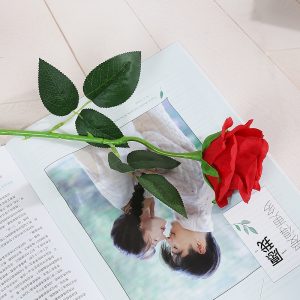Artificial flowers have become an increasingly popular element in modern interior design trends due to their versatility, low maintenance, and ability to add a touch of nature to any space. Here are some ways artificial flowers are being used in interior design:
- Minimalistic Arrangements: Artificial flowers are used to create sleek and minimalist arrangements that add a subtle, yet elegant, touch of color and texture to contemporary interiors.
- Statement Pieces: Large, eye-catching arrangements of artificial flowers serve as focal points in rooms, making a bold statement and drawing attention to specific areas.
- Vertical Gardens: Vertical gardens or green walls made with artificial flowers provide a lush and vibrant backdrop to interiors, without the need for live plants that require constant care.
- Long-Lasting Decor: Interior designers are turning to artificial flowers for long-lasting decorations that retain their beauty throughout the seasons, saving homeowners the hassle of replacing fresh flowers frequently.
- Seasonal Transformations: Designers are using artificial flowers to easily switch out decor based on seasons or occasions. This allows for thematic changes without the limitations of live flowers’ availability.
- Event Decor: In event spaces and hospitality settings, artificial flowers are favored for their durability during weddings, parties, and other occasions, ensuring that the decor remains pristine throughout the event.
- Hotel Lobbies and Offices: Artificial flower arrangements in hotel lobbies and corporate offices offer a welcoming and professional ambiance without the maintenance required by real plants.
- Retail Displays: Retail stores use artificial flowers to create visually appealing window displays that remain fresh-looking regardless of the time of year.
- Luxury Decor: High-quality artificial flower arrangements made with silk or realistic materials are chosen to convey a sense of luxury and opulence.
- Mixed Materials: Designers are combining artificial flowers with other materials, like wood, glass, and metal, to create unique and artistic arrangements.
- Color Coordination: Artificial flowers are selected to match or complement the color scheme of a room, allowing for precise color coordination in design.
- Non-Allergenic Spaces: For individuals with allergies, artificial flowers are a perfect choice, as they add a touch of nature without introducing allergens into the environment.
- Sustainability: In the context of sustainable design, artificial flowers are preferred for their reduced environmental impact compared to the frequent replacement of fresh flowers.
- Texture and Depth: Artificial flowers with intricate textures and shapes are used to add depth and visual interest to interior spaces.
- Mixing Real and Artificial: Some designers are skillfully combining real and artificial flowers in arrangements, creating a balance between the beauty of fresh flowers and the longevity of artificial ones.
Remember that the key to successfully incorporating artificial flowers into interior design is to select high-quality options that closely resemble real flowers and to integrate them in ways that enhance the overall aesthetic and ambiance of the space.
























